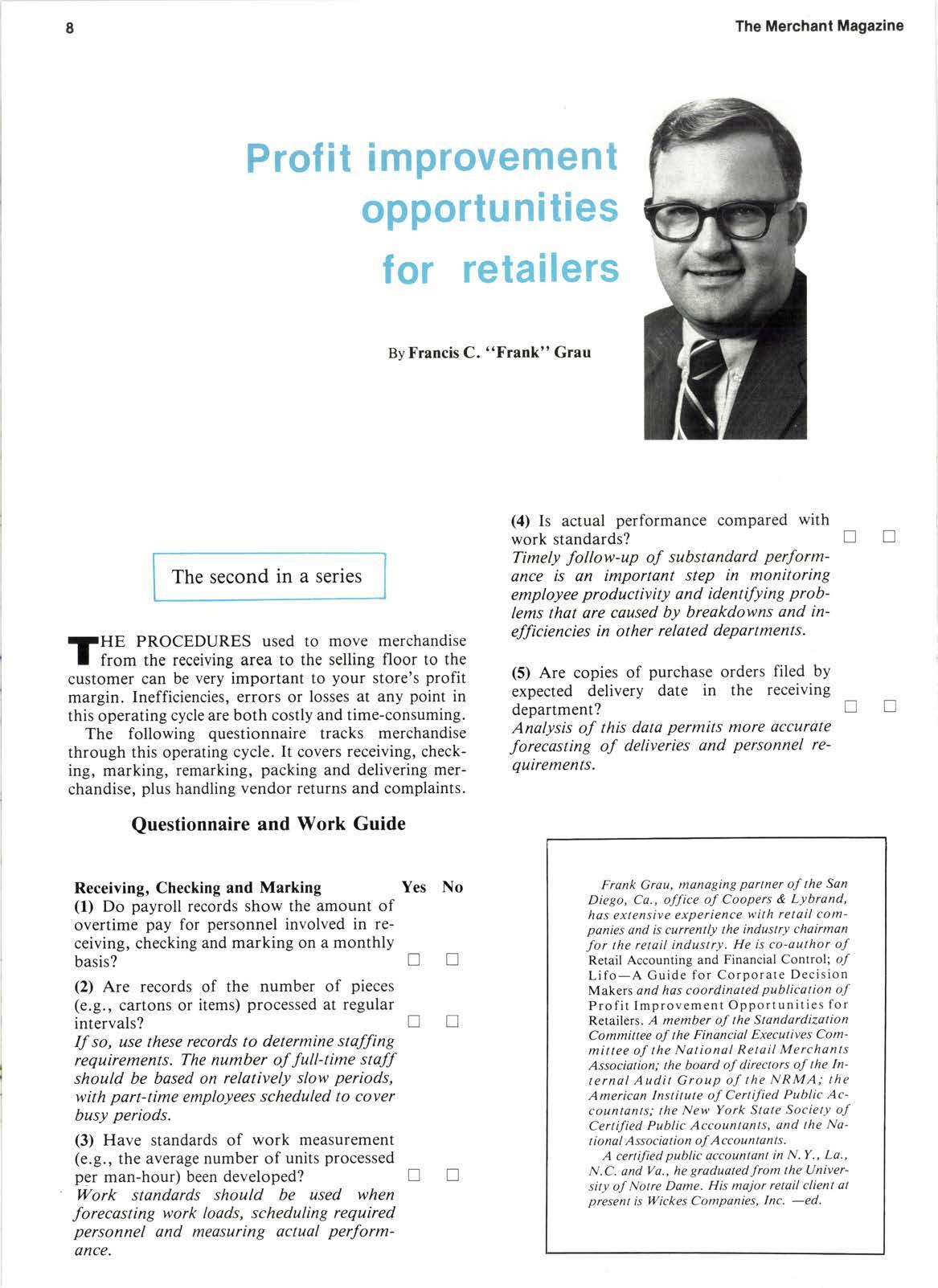
4 minute read
Profit improvement opportu nities f
The second in a series
Or Retailers
By Francis C. "Frank" Grau
I'HE PROCEDURES used to move merchandise
I from the receiving area to the selling floor to the customer can be very important to your store's profit margin. Inefficiencies, errors or losses at any point in this operating cycle are both costly and time-consuming. The following questionnaire tracks merchandise through this operating cycle. It covers receiving, checking, marking, remarking, packing and delivering merchandise, plus handling vendor returns and complaints.
Questionnaire and Work Guide
Receiving, Checking and Marking
Yes
(1) Do payroll records show the amount of overtime pay for personnel involved in receiving, checking and marking on a monthly basis? !
(2) Are records of the number of pieces (e.g., cartons or items) processed at regular intervals? n
If so, use these records to determine staffing requirements. The number of full-time stafJ should be based on relatively slow periods, with psrt-time employees scheduled to cover busy periods.
(3) Have standards of work measurement (e.g., the average number of units processed per man-hour) been developed? I Lltork standards should be used when forecasting work loads, scheduling required personnel and measuring actual performance.
(4) Is actual performance compared with work standards?
Timely follow-up of substandard performance is an important step in monitoring employee productivity and identifying problems that are caused by breakdowns and inefficiencies in other related departments.
(5) Are copies of purchase orders filed by expected delivery date in the receiving department? tr
Analysis of this dsta permits more occurote forecasting of deliveries and personnel requirements.
Frank Grau, manoging partner of the San Diego, Co., ofJice of Coopers & Lybrand, has extensive experience with retail com' panies ond is currently the industry chairman for the retail industry. He is co-author of Retail Accounting and Financial Control; o/ Lifo-A Cuide for Corporate Decision Makers and has coordinated publication oJ Profit Improvement Opportunities for Retailers. A member of the Standardization Committee oJ the Financial Executives Com' mittee of the National Retail Merchants Association; the board of directors of the In' ternal Audit Group of the NRMA; the American Institute of Certified Public Ac' countants; the New York State Society oJ Certified Public Accountants, and the Na' t io nal A ssocia t ion of Accoun ta nts.
A certified public accountant in N.Y., La., N.C. and Va., he graduated from the University ol Notre Dome. His maior retail client at present is Wickes Companies, Inc. -ed.
(6) Is the receiving department informed in advance of buying and promotion department activities?
'Such advance notice will help determine receiving department work schedules.
(7) For checiing purposes, are purchase orders written for all commitments to vendors?
Without a purchase order, special handling required in the receiving department causes deloys in moving merchandise to the selling floor.
(E) Are purchase order terms explicit?
Precise delivery instructions and item descriptions ore required to check incoming orders.
(9) Are open receiving documents regularly reviewed?

Open items should be followed up with reasonable frequency (e.g., every l0 days).
(10) Is a copy of the purchase order used as a receiving report?
A copy of the purchase order can be effectively used to receive, check and mark merchandise quickly, especially when the vendor foils to include an invoice or pocking slip, or does not identifu the shipment with the purchsse order number.
(11) Is the order checking group working on current invoices?
This group should be able to resolve problems on a current basis.
(12) Are invoice problems summarized by their nature?
Analysis of the causative factors may disclose operating prob lems.
(13) Are other store employees (e.g., support personnel) used as part-time markers during their slow periods?
Flexibility in using store personnel should reduce the need for part-time employees.
Story at a Glance
Vendor Returns and Complaints
(1) Do buyers get vendor approval before returning merchandise?
Unauthorized returns may result in delays, confusion and errors.
(2) Is credit approval required for vendor returns that exceed an established minimum? Returning merchundise to vendors with poor credit standing may lead to "known s h ri n ka ges " (i. e., w ri t e- offs of unc o llect ib le debit balances). Credit approvalby accounts payable should be required for vendor returns over o predetermined amount. Approval of the controller or general merchandise mapager should be required for returns of very lorge amounts.
(3) Are established procedures followed when merchandise is returned to vendors for credit or repair?
Merchandise returns to vendors should be documented on an opproved "Invoice to Vendor" or "Repoir and Return" form. Price tickets should be removed from the merchandise only when the "Return Goods Room" checks the retail prices with the appropriate form.
(4) Is adequate security maintained over outgoing vendor returns?
An offixed return-form oddress lubel should be visible on every outgoing vendor return. Merchandise should not leove the store or worehouse without inspection of this label at the exit.
Wrapping, Packing and Delivering
(1) Do wrappers and packers compare merchandise to sales checks?
The contents of packages being wrapped and/or delivered should agree in quantity, price and department number with items listed on the sales checks.
(2) Are there established procedures to follow when merchandise taken from stock exceeds the quantity shown on the sales check?
Personnel should have instructions for reporting these discrepancies so they can be immediately investigoted.
(3) Is merchandise adequately protected and monitored when it is being moved from the selling departments to the delivery area?
An opportunity for employee theft is crested when merchandise in transit is not properly monitored.
(4) Does the delivery department examine merchandise received from the selling floor?
A record should be made of damaged goods and all merchondise returned to the selling departments. The internal loss and damage procedure should be periodically reviewed to










